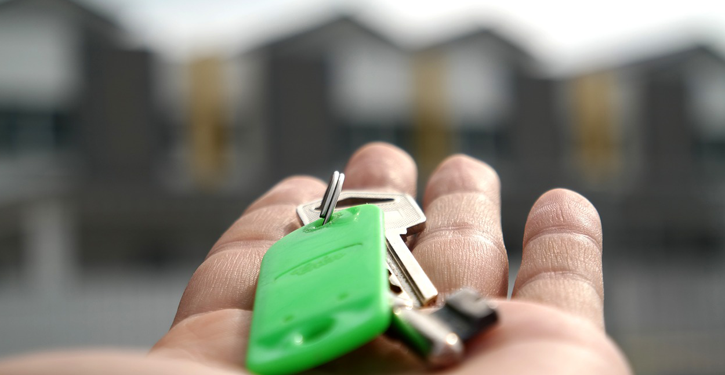Buying a home is a big deal, and you’ll need to cross many Ts and dot many Is before you can call yourself a homeowner.
One of the biggest obstacles you’ll face is the down payment.
Your down payment is a lump sum of cash you pay in advance against the home’s purchase price. This is different from earnest money, which you may have to pay to the seller after you’ve made an offer, or closing costs, which cover all the administrative and legal fees that must be paid before you can take ownership of the property.
The bigger your down payment, the less money you have to borrow. For example, if you’ve got your eye on a $200,000 home and you can afford to make a 20 percent down payment ($40,000), you will borrow $160,000.
How big should your down payment be, and what are the pros and cons to paying more (or less)?
Down Payments and the 20 percent Rule
The 20 percent rule doesn’t dictate how much money you need to bring to the table to buy a home, but it does impact your loan eligibility and mortgage costs.
In a nutshell, if you put less than 20 percent of the purchase price down on a home, you’ll most likely have to pay private mortgage insurance or PMI.
What is PMI?
Private mortgage insurance is an insurance premium the lender adds on to your mortgage. This insurance protects the lender in case you default on your mortgage. How long you have to pay PMI depends on the type of mortgage you have.
With a conventional loan—a mortgage that’s not backed by a government agency—you could pay your way out of PMI once you reach 20-25 percent equity value in the home (depending on the loan and lender). for the life of the loan. The only way to cancel it is to refinance into a conventional mortgage.
On an FHA loan, mortgage insurance is required for the life of the loan, no matter how much equity you have.
There are two types of premiums: an upfront premium and a monthly premium. All FHA loans have an upfront MIP (mortgage insurance premium) and a monthly MIP, but conventional loans have only a monthly MIP.
Most FHA borrowers roll the upfront MIP into the loan balance and finance it along with the amount borrowed. This is not required, and in fact makes the loan more costly. Monthly premiums are always tacked on to the regular monthly payment. Whether you pay an upfront premium with a conventional loan depends on how the lender chooses to structure your mortgage. With an FHA loan, you pay both premiums.
Example of an FHA loan with MIP
For example, assume that you want to buy a $200,000 home with 3.5 percent down through the FHA program and you qualify for an interest rate of 4 percent. Your down payment is $7,000. You want to borrow $193,000.
The upfront MIP is 1.75 percent of the purchase price, which equates to $3,500. This amount is added to the principal.
You will also pay an annual mortgage premium of 0.85 percent of the loan amount (not including the rolled-in upfront MIP), which breaks down to $136.71 per month.
Assume you pay $1,200 a year for homeowner’s insurance and $1,200 a year for property taxes, both of which are escrowed into your payment.
Your total monthly payment, including the principal, interest, taxes, homeowner’s insurance and private mortgage insurance premiums, is $1,274.83.
Lender-paid and single-premium PMI
With lender-paid PMI, the lender pays your mortgage insurance for you, in exchange for a higher mortgage rate. This option could result in a lower mortgage payment than if you were to pay PMI monthly. This could also help you qualify for a larger mortgage. Like FHA MIPs, lender-paid PMI can’t be canceled. You will have the higher interest rate for the life of the loan, regardless of how much equity you have in the property.
Single premium PMI means you pay the mortgage insurance premium upfront in a lump sum, either in cash or by financing it into your loan amount. Single premium PMI is nonrefundable. Depending on whether and when you sell the home, you could end up prepaying for insurance that you don’t need.
PMI exceptions
Some low down payment mortgage programs do not require PMI. Bank of America, for example, launched the Affordable Loan Solution® program in 2016, which caters to low-income homebuyers. This program allows qualifying buyers to purchase a home with as little as 3 percent down and no private mortgage insurance. Eligibility for the program is based on income, loan size is limited and borrowers may not own additional properties at closing. Other restrictions apply.
Alternative lender Social Finance offers another no-PMI borrowing option. Borrowers can put as little as 10 percent down on a home loan of up to $3 million with no borrower-paid mortgage insurance required. The tradeoff for this flexibility is that you may pay a higher interest rate than you would on a conventional loan from a traditional lender.
Avoiding PMI with piggyback loans
A piggyback mortgage is one way to avoid mortgage insurance. A piggyback mortgage is a second mortgage and can be for any amount, but it is generally meant to cover the difference between the amount of money you have for a down payment and 20 percent of the property value. For example, you have enough cash to pay 10 percent down, you take a primary loan for 80 percent of the loan value and you take a piggyback loan for the remaining 10 percent.
Piggyback mortgages typically follow second mortgage guidelines. They often come with a variable versus fixed interest rate. A piggyback may also have a shorter repayment term. For example, you may have a 30-year primary mortgage and a 10-year piggyback loan.
Why does PMI matter?
Whether you have to pay private mortgage insurance premiums is an important consideration because it affects your out-of-pocket costs for a very long time. When the upfront premium is rolled into an FHA loan, it increases the financed (borrowed) amount. That means you will pay interest on the upfront premium for the entire life of the loan.
The monthly premiums also push the cost of owning a home higher. We all have a budget. PMI increases the monthly payment, which could lower the dollar amount you can afford to borrow. You may have to buy a home with a smaller price tag, perhaps one that does not meet your needs as well as a more expensive property.
Can You Buy a Home With Less Than 20 percent Down?
A common misconception is that the 20 percent rule is set in stone and without that much cash you won’t be able to buy. While a 20 percent down payment is generally required for the best terms, it’s not required to get into homeownership.
Depending on the strength of your credit profile and financials, you may be able to buy a home with significantly less than 20 percent down. For example, with a high credit score and minimal debt, a lender might approve you for a loan with as little as 5 or 10 percent down.
Some mortgage programs (FHA, VA) allow buyers with imperfect credit to get a loan with as little as 3.5 percent down.
For an FHA loan with 3.5 percent down, you need a minimum credit score of 580. The VA loan program is a homebuying pathway for veterans. Likewise, USDA loans allow eligible buyers living in rural areas to buy a home with no money down and a credit score of 640 or better. USDA loan eligibility is limited by income as well as zip code.
Programs exist for $0 down mortgages, too, and many are targeted to the military community. Again, the VA (Veterans Administration) is a good source for these low-down loans. The VA does not make loans. A private lender must offer the loan, and then the VA guarantees it (for eligible borrowers). The USDA also guarantees $0 down loans as part of its Rural Development mortgage program.
NASA, Navy Federal and Travis Credit Unions all offer $0 down mortgages to qualified members.
Fannie Mae offers two programs that allow buyers to get a mortgage with just 3 percent down. The Conventional 97 program is available to buyers with above-average credit scores and the HomeReady program is open to low and moderate income buyers who have a good credit track record.
While you can buy a home with less than 20 percent down, consider carefully whether you should. If it means paying private mortgage insurance, be sure you understand the long term impact to cost. Plug the numbers into Credit Sesame’s mortgage calculator for an idea of what you can expect to pay.
Think about how long you plan to stay in the home. If you’re looking for a starter home and you think you might move within five years, a low-down mortgage might be a great way to get into homeownership. On the other hand, if you’re planning to buy your dream home right out of the gate, a larger down payment is virtually guaranteed to reduce the long-term cost to own.
Building a Down Payment Fund
The more time you have, the better because you have longer to save your down payment.
As you save, know how much you need and where to keep it.
Let’s start with the second question, since this one’s a little easier to answer. Your down payment fund should be relatively easy to access but you also want to earn interest on your savings. The better the annual percentage yield, the faster your down payment account can grow.
A traditional savings account is one option but an online savings account or money market account is likely to offer a higher APY. Some money market accounts offer the added benefit of check writing privileges so once you’re ready to buy, you can just write a check without the need to transfer funds.
A Certificate of Deposit is also a good option. CDs tend to earn more than traditional savings accounts. The downside is that you need to leave the funds in the account until the date of maturity or you will pay a penalty. To mitigate the risk, choose a CD with a maturity date that more or less matches your savings timeline (three years, five years and so on). You can also put some of the money in a short-term CD and some in a longer-term CD, since longer-term CDs earn higher rates.
If you’re not already a Credit Sesame member, take a minute to sign up for a free account. Then log in and view personalized banking recommendations to find an account that will work best for your down payment savings.
How much money do you need to buy a home?
The answer to this question is different for every buyer and depends on several things, including:
- The purchase price of the home you want to buy
- The type of loan you get
- Your timeline
- Your credit rating
- Your overall financial health
- Your long-term plans for owning the home
If you absolutely want to avoid mortgage insurance, then save enough to make a 20 percent down payment. On the other hand, you can set the bar a little lower if you’ve done the math on PMI and you’re comfortable having the added costs included in your mortgage.
Don’t neglect your other financial goals. If you have student loans or credit card debt, for example, a smaller down payment could free up funds that you could use to knock out some of your debt. Be sure you have at least a three-month emergency fund, too. The mortgage lender will probably require it.
Essentially, you have to find the right balance between getting a down payment together and checking off the other items on your financial to-do list.
When your down payment fund falls short
If you’re not seeing your down payment savings grow as fast as you like, but avoiding PMI is still a priority, you do have some options for getting help.
Down payment assistance
Down payment assistance programs are administered by national, state and local organizations and while they operate differently, the goal is the same–to help qualified buyers purchase a home when they have limited resources for the down payment or closing costs.
Some down payment assistance programs, for example, offer grants to eligible homebuyers. Grant funds can be used to cover your down payment costs and generally, you don’t have to repay them if you live in the home for a set number of years. Other programs offer a matching savings account, similar to a 401k. You add money to the account and the assistance program matches your contributions, usually up to a certain limit.
Each program has different guidelines for determining who qualifies. Some are limited geographically. Others use your income as a deciding factor. Either way, these programs can go a long way towards reducing the burden of coming up with a down payment if you’re eligible.
For example, the HomeFirst Down Payment Assistance Program helps qualified New Yorkers with up to $25,000 in down payment funds. You must be buying a home, condo or co-o within the five boroughs and meet specific income guidelines. The Golden State Finance Authority offers up to 5 percent of the home’s purchase price in assistance to California homebuyers. On a $300,000 loan, that’s $15,000.
Down payment gifts
Some buyers ask a family member to gift the money for a down payment. There are two caveats to keep in mind, however.
First, lenders impose a few rules regarding how much money can be gifted. If you’re getting an FHA loan, it’s okay to fund 100 percent of your down payment with a gift. For most conventional loans, on the other hand, the amount that can be gifted depends on how much the total down payment is.
If the down payment is 20 percent or more, all of it can come from gifted funds. If it’s less than 20 percent, however, some of the money must come out of your own pocket. The actual amount is determined by the mortgage insurance provider.
The other thing you need to know is that down payment gifts must be thoroughly documented. You’ll need a written statement from the donor specifying the amount of the gift, the date it was made, their name, address, phone number, and relationship to you, the address of the property you’re buying and a statement which clearly states that the money is indeed a gift. The lender may also need to see bank statements or other financial documents that prove the source and path of the money.
Borrowing from your retirement
If you have money set aside for retirement, you may consider using this money as a down payment. For instance, you could take a loan from your 401k to fund a home purchase. The idea is attractive, but it comes with distinct downsides.
First, 401(k) loans must be repaid, generally within five years. If you leave your job before the loan is paid in full, any outstanding amount becomes due immediately. If you’ve borrowed a significant amount, that balloon payment could be problematic, and if you can’t come up with the cash you’ll face a significant tax penalty. Loans that are not repaid are treated as taxable withdrawals, meaning the full amount is subject to ordinary income tax plus a 10 percent early withdrawal penalty if you are under age 59 ½.
The other obvious drawback is that when you take money out of a 401k, even as a loan, you lose the opportunity for growth on those funds. You may be able to make new contributions after a loan but you can’t replace what you’ve taken out all at once nor the number of years of compound growth. Depending on your plan, you may face a waiting period before you can begin making new contributions. The longer the delay, the more compound interest you’re missing out on.
Remember, the most valuable aspect of long-term savings is time. Money saved earlier and longer is always worth more.
You could execute a standard withdrawal in place of a loan but if you do you are automatically subject to both ordinary income tax and the early withdrawal penalty if it applies. Again, you’re depleting your retirement savings. Between increasing your tax burden temporarily and shrinking your nest egg, a 401k withdrawal is the least favorable option for coming up with down payment funds.
Note that you can withdraw up to $10,000 from an individual retirement account (IRA) towards a home purchase penalty-free. You will, however, pay income tax on withdrawals from a traditional IRA, or on earnings withdrawals from a Roth IRA that’s been open for less than five years.
Let Credit Sesame help with your mortgage search
The down payment is just one part of the mortgage process. If you’re ready to buy but you’re not sure how to get started, Credit Sesame’s mortgage loan research center can get you started. You can learn about different mortgage types and then log in to your Credit Sesame account to get mortgage loan recommendations based on your credit profile so that you can embark on a smooth, well-informed homebuying experience.


























